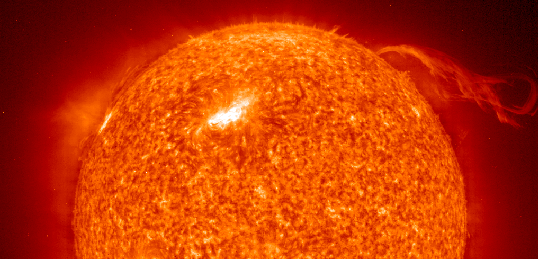ASTR 511 (O'Connell) Lecture Notes

Sun in H-alpha showing active regions
and
a flame-like "prominence."
I. INTRODUCTION
There are many distinct types of astrophysical sources: stars, AGNs, planets, H II regions, synchrotron jets, hot intracluster gas, shocked gas (SNRs), etc Main issues:- Generation of photons
- Transfer of photons to observer = radiative transfer
- Deduction of physical properties from emergent spectrum
- Many different mechanisms
- Usually several types important in given source
- Mechanisms usually broad-band, but often dominate distinct bands
- "Thermal" vs "non-thermal"
- Thermal: emitters/absorbers close to Boltzmann distribution ("thermal
equilibrium" or TEQ)
- In many, not all, cases, radiation field is close to
 , the Planck function
, the Planck function
- In many, not all, cases, radiation field is close to
- Non-Thermal: emitters/absorbers/radiation far from TEQ
- Best example: synchrotron sources = continuum radiation from relativistic electrons with non-Maxwellian energy distribution moving in magnetic fields. If e-energy distribution is a power law, so is emitted radiation.
- Thermal: emitters/absorbers close to Boltzmann distribution ("thermal
equilibrium" or TEQ)
- The underlying complexity of typical sources is emphasized by the image of the Sun at the top of the page. We are aware of the many different physical environments on the Sun's surface only by virtue of its proximity.
- Transfer is characterized by the optical depth,

- Probability of escape from
a given location in the source is

-
 : "optically thin".
See directly to sources of photons.
: "optically thin".
See directly to sources of photons.
-
 : "optically thick".
Observed photon distribution has been transformed in
: "optically thick".
Observed photon distribution has been transformed in  , direction, and/or intensity.
, direction, and/or intensity.
- NB: "Thick" does not mean "dark." (The Sun is optically thick!) Rather, observable photons escape only from outermost ~ 1 optical depth of source.
- Propagation of photon energy is described by the "equation of transfer"
- How to relate observables to source physics? This is one of the principal concerns of theoretical astrophysics.
II. COMPARISON OF TWO CANONICAL SOURCE TYPES
In this section, we discuss two canonical types of astrophysical sources: STARS & AGNs and compare them in the following characteristics:- Structures
- Spectra: Continua
- Spectra: "Lines" (fine structure)
- Information carried by their spectra
| STRUCTURES |
|---|
STARS:
|
|
AGNs ("Active Galactic Nuclei"):
|
| CONTINUUM SPECTRA |
|---|
STARS
|
|
AGNs:
|
| LINE SPECTRA |
|---|
STARS:
|
|
AGNs:
|
| DEDUCTIONS FROM OBSERVATIONS |
|---|
STARS:
|
|
AGNs:
|
References:
- Properties of stars: D. F. Gray (1992) "Observation & Analysis of Stellar Photospheres"
- Properties of AGNs: B. M. Peterson (1997) "An Introduction to Active Galactic Nuclei"
- Spectroscopy: LLM, Sec. 5.1
 Previous Lecture
Previous Lecture
|
 Lecture Index
Lecture Index
|
 Next Lecture
Next Lecture
|
Last modified December 2020 by rwo
Text copyright © 2000-2020 Robert W. O'Connell. All rights reserved. These notes are intended for the private, noncommercial use of students enrolled in Astronomy 511 at the University of Virginia.
 Isotropic radiators.
Isotropic radiators.
 1016 cm.
1016 cm.
 . These can generate relativistic jets.
. These can generate relativistic jets.

 at any wavelength.
at any wavelength.
 peak at
peak at  Å
Å
 to peak, then dropoff.
to peak, then dropoff.
 1 pc
1 pc 
 is the angular area
(or upper limit) of the source. Is T "unphysically" high?
is the angular area
(or upper limit) of the source. Is T "unphysically" high?